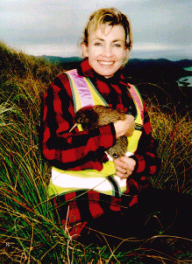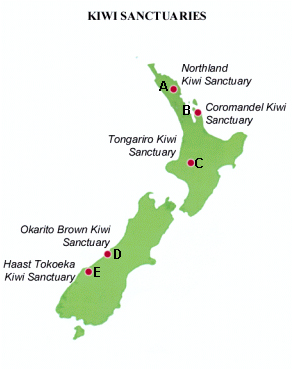This task is about finding information in a text and using it to make inferences.
Read the article. Then use the information you find to answer the questions that follow.
During the year, work on protecting kiwi in five sanctuaries throughout the country gathered momentum. Three sanctuaries in Northland, Coromandel, and Tongariro, will protect the North Island brown kiwi, while two sanctuaries on the South Island's West Coast will protect the Okarito brown kiwi and the Haast tokoeka kiwi respectively:
A. Intensive predator trapping is underway in the Northland Kiwi Sanctuary. In addition, kiwi eggs are being collected and sent to the Auckland Zoo and Whangarei Native Bird Recovery Centre for care. Last season they raised 15 chicks till they were large enough to look after themselves.
B. In the Coromandel, 1350 stoat traps are set up through the Moehau Kiwi Zone, this is due to increase to 2200 traps covering the whole kiwi habitat. Kiwi sanctuary funding is also helping Project Kiwi, a community project just north of Whitianga.
C.The Tongariro Kiwi Sanctuary was aerially treated with 1080 last year to reduce stoat and rat numbers. The 32 adult kiwi that were monitored within the sanctuary all survived the operation and, of the 14 new chicks carrying radio transmitters, 50% are still alive. This is a big improvement on the expected chick survival of just 5% in unmanaged populations. As in Northland, kiwi chicks are being raised in captivity before being released back into the wild.
D.Okarito Kiwi Sanctuary, the first two captive-reared kiwi began breeding. The sanctuary has been using Motuara Island where the chicks are reared before being released back into South Okarito Forest. About 1500 stoat traps are also placed around.
E. In the Haast Tokoeka Kiwi Sanctuary, an intensive predator control operation has helped boost the survival of the Haast tokoeka chicks. This year was the first time, since monitoring began in 1997, that chicks have survived past a few weeks old. The Haast tokoeka (meaning weka with a 'toko', or walking stick) is a critically endangered variety of kiwi numbering about 250 birds. The 12,000 ha Haast Tokoeka Sanctuary was created to maintain a viable wild population of Haast tokoeka between the Waiatoto and Arawhata rivers south of Haast.
Text source: 'Conservation Action Te Ngangahau ki te Kura Taiao', DOC at Work. July 2001-2002.


Image source: Chrissy Wickes, DOC.